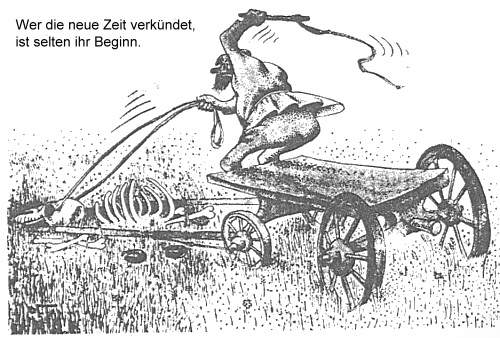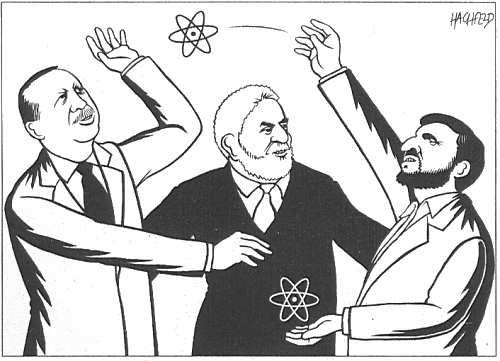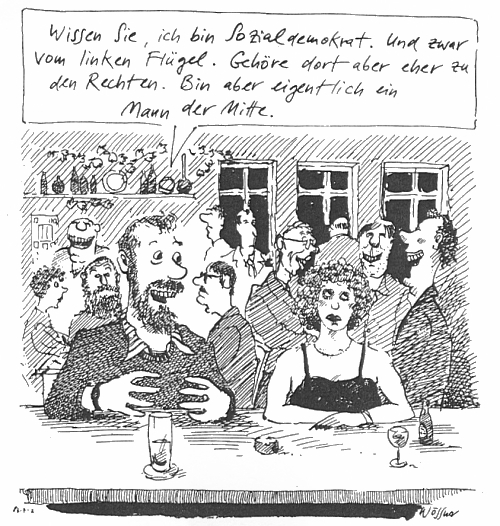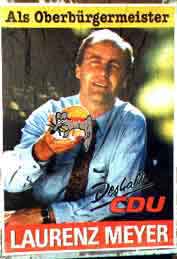| The reactor bankruptcy - THTR 300 | The THTR Circular |
| Studies on THTR and much more. | The THTR breakdown list |
| The HTR research | The THTR incident in the 'Spiegel' |
The THTR Circulars from 2010
***
| 2023 | 2022 | 2021 | 2020 | ||
| 2019 | 2018 | 2017 | 2016 | 2015 | 2014 |
| 2013 | 2012 | 2011 | 2010 | 2009 | 2008 |
| 2007 | 2006 | 2005 | 2004 | 2003 | 2002 |
***
THTR Circular No. 132, July 2010
Content:
South Africa: world champion of waste?
Angra 3 nuclear facility, Brazil
HTR planned in Poland?
Herter: Marcig right
South Africa: world champion of waste?
 The development of the Pebble Bed Modular Reactor (PBMR) in South Africa has cost around one billion euros in recent years. That is 70 percent of the cost of building the new FIFA stadiums for the World Cup (1). Despite the immense use of funds, the attempt to build a high-temperature reactor in Africa ended in fiasco.
The development of the Pebble Bed Modular Reactor (PBMR) in South Africa has cost around one billion euros in recent years. That is 70 percent of the cost of building the new FIFA stadiums for the World Cup (1). Despite the immense use of funds, the attempt to build a high-temperature reactor in Africa ended in fiasco.
As early as January 2009, the radioactive spherical fuel elements for the PBMR, manufactured in South Africa with German help, were shipped to the USA in order to continue experimenting with them there (2). The workforce of the semi-state PBMR company will be reduced from 2010 to 800 by the end of 200. In the meantime, many employees have given up and have looked for new jobs in other countries.
In June 2010 it was announced that the number of employees would be reduced again to a ridiculous 25 in order to be able to continue to exist as a nurtured mailbox company and maintain rudimentary know-how for at least the next one or two years with a low budget (3).
Loads of flaws and problems
South Africa has to save. Poverty, AIDS and crime are troubling the country. There is a lack of money everywhere. New investors for the controversial project are not in sight. In the meantime, the waste and mismanagement associated with the development of the PBMR is openly criticized and discussed in the media. "Mail & Guardian Online" (4) listed a number of organizational problems and deficiencies in the development of the PBMR in April 2010: - Disputes between PBMR managers and the nuclear supervisory authority, unauthorized assignments, unrealistic applications. - Contractual partners often exceeded the agreed budget. - In order to trick other countries into bankruptcy, PBMR managers traveled extensively all over the world; most expensive hotels were frequented. The manager Ferreira stated that the travel costs "only" made up less than 1 percent of the previous PBMR costs. Not quite 10 million euros in travel expenses are certainly not a small amount. - The number of employees has been artificially increased because the anti-discrimination measures prescribed in South Africa must be followed. Instead of 800 employees, 300 to 400 would have been enough. - The methods of the former chief manager Jaco Kriek were controversial because he could not cope with the numerous conflicts of interest. - Even Johan Slabbert, PBMR Chief Technology Officer, admitted that the South African nuclear industry was still too underdeveloped to handle a demanding project like the high-temperature reactor.
The withdrawal from the bankruptcy reactor
The South African Minister Barbara Hogan gave during a parliamentary debate (5) that the planned PBMR project only made it to the research and development phase and was still a long way from the completion of a real reactor. Despite these setbacks, in your opinion, energy policy should be based on nuclear models in the future. These will then probably be pressurized water reactors.
On June 1, 2010, the South African nuclear supervisory authority informed parliament that the PBMR company had withdrawn the application for the construction of a high-temperature reactor (6)! This heralded the hopefully final farewell to a reactor line that was made palatable to the criminal regime of the time by representatives of the United Electricity Works (VEW) from Dortmund during the apartheid era. After all, South Africa now has an advantage over the FRG: It has no radiant reactor ruins like the THTR Hamm, whose nuclear waste has to be taken care of for thousands of years.
With the pebble bed reactor in South Africa, an important prestige object has slipped out of the hands of the depressed nuclear community. The "18th International Conference on High Temperature Reactor Technology HTR" planned for October 20-5 in Prague was initially on the brink in view of the latest events, but will still take place with a reduced program (7). Now is the time for atomists to "lick wounds".
- "Fin24" from May 26, 5
- See "THTR-Rundbrief" No. 131, "PBMR: The penultimate contingent - with Obama dollars!"
- "Engineering News" from June 4, 6
- "Mail & Guardian Online" from April 23, 4
- Aus: http://www.pmg.org.za/briefing/20100415-minister-public-enterprises-media-briefing-budget-speech
- See 3
- See: www.htr2010.eu
"Angra 3" nuclear facility, Brazil:On the Westerwelle to the nuclear Nazis and back |
When Foreign Minister Guido Westerwelle visited South America in March 2010, it was initially nothing special that he was accompanied by numerous corporate representatives in order to initiate new business. Many other heads of government and ministers have done the same before. It will also not astonish anyone that Westerwelle is happy to help the nuclear industry get new contracts abroad. It is astonishing, however, how straightforward Westerwelle acts within historical continuities that go back to the time of fascism when German Nazi scientists carried out nuclear research for the "final victory".
2,5 billion euros Hermes guarantee
"Westerwelle campaigned 'massively' for the nuclear industry and 'fully confirmed' the German-Brazilian nuclear agreement of 1975", quoted the TAZ (1) Ulrich Gräber, the accompanying managing director of the Franco-German nuclear company Areva, in which Siemens holds a third of the shares. Among other things, it concerns the further construction of the Brazilian kiln Angra 3 by Areva / Siemens and the 2,5 billion Hermes guarantee from the German state for this controversial project. Controversial "not only because Brazil refuses to sign the Additional Protocol to the Nuclear Non-Proliferation Treaty. But also because there is no independent nuclear regulator in the country" (2). Brazil now sees itself as a global player in nuclear policy and tries to distinguish itself as a mediator in the Iran conflict - with interests of its own.
From 1964 to 1985, Brazil was ruled by a military dictatorship. In Angra, of all places, the only earthquake-prone area in Brazil, the three nuclear reactors were supposed to be built. "Neither the land rights of the locals were recognized, nor was there an open discussion with the population" (3) reported the head of the environmental organization SAPE, Rafael Ribeiro. "Angra 1 nuclear power plant cost $ 2 billion; Angra 14 cost another $ XNUMX billion" (4) Greenpeace quantified the costs.
Military dictatorship, repression and debt
Economically, Angra 1 and 2 were a disaster for heavily indebted Brazil. "The value of the German-Brazilian nuclear package reached about 1979 billion dollars in 45. How this amount could be paid in view of the high debt of the country, the Bonn government had probably not given any thought; only the financing of the first reactor to be built in Angra seemed to be secured "(5). Even under the dictatorship of General "Alemano" Geisel, there was criticism of the nuclear treaty of the century. But this was suppressed: "The press should be censored. Combat funds of the Lausanne-based export cartels of the German electrical industry - IEA - began to finance the Brazilian repression. Geisel's dictatorship was the favorite child of German corporations. Peter von Siemens visited the dictator in Brasilia personally" (6).
The construction time for Angra 2 was 25 years! The kiln was only completed in 2000. "Angra 3 started in 1984. It was discontinued two years later. Since then, the components have been stored in tropicalized packaging and cost 15 million euros a year" (7). Exactly these mothballed ruin parts are now to be reanimated again as a result of Westerwelle's journey.
In Genscher's footsteps: Nuclear-liberal continuities
During his nuclear support tours, Westerwelle follows in the footsteps of his liberal predecessor Hans-Dietrich Genscher, who was Minister of the Interior from 1969 to 1974 and then Minister of Foreign Affairs until 1992. As Minister of the Interior, Genscher was also responsible for "environmental protection measures". During this time, in 1972, sixty officers from the Brazilian military dictatorship visited the nuclear research center in Jülich, where uranium centrifuges were being put into operation and Brazilian scientists were being trained. Three years later, Foreign Minister Genscher and his Brazilian counterpart Azeredo da Silveire signed the German-Brazilian nuclear treaty, which included eight reactors, uranium enrichment and reprocessing. In 1976, the financing agreement with the credit protection through Hermes guarantees by Germany took place. In 1978, Juntachef Geisel also expressed interest in the THTR during a visit to Bonn.
The goal: nuclear weapons
 Brazil has the sixth largest uranium deposits in the world and a total of one billion dollars in reprocessing technologies. Not only to reduce uranium enrichment costs by 30 percent, but to be able to build atomic bombs. During the inspection of the International Atomic Energy Agency IAEA in the Resende uranium enrichment plant 160 kilometers from Rio de Janeiro, the inspectors were not given access to central parts of the plant in 2004 (8). "While Iran is under massive pressure from the Western powers under US leadership because of its nuclear program, Brazil is opening a uranium enrichment center without taking the slightest offense. (...) Brazil is on a path that is very much like that of Iran is similar, but Iran gets all the attention "(9).
Brazil has the sixth largest uranium deposits in the world and a total of one billion dollars in reprocessing technologies. Not only to reduce uranium enrichment costs by 30 percent, but to be able to build atomic bombs. During the inspection of the International Atomic Energy Agency IAEA in the Resende uranium enrichment plant 160 kilometers from Rio de Janeiro, the inspectors were not given access to central parts of the plant in 2004 (8). "While Iran is under massive pressure from the Western powers under US leadership because of its nuclear program, Brazil is opening a uranium enrichment center without taking the slightest offense. (...) Brazil is on a path that is very much like that of Iran is similar, but Iran gets all the attention "(9).
Nazi scientists help build Brazil's nuclear program
The FRG had shown how to cheat about thorough international nuclear controls in 1967 when it came to postponing the signing of the Nuclear Non-Proliferation Treaty and weakening it for the FRG through restrictive additional clauses. Robert Jungk wrote in his book "Atomstaat": "From the beginning, the Federal Republic of Germany put up the most energetic resistance to intensive inspection measures, such as those Washington wanted to enforce" (10).
Genscher, himself a member of the German atomic forum for many years, was close friends with Karl Winnacker, who was general director of the notorious IG Farben during World War II (11). After 1945, Winnacker became President of the German Atomic Forum and a leading member of various other atomic commissions. In this capacity he worked out the restrictions under which the FRG finally signed the Nuclear Non-Proliferation Treaty in 1969.
The Brazilian historian Otto Buchsbaum describes the prehistory of the nuclear cooperation between Nazi Germany and Brazil and the role of Karl Winnacker as follows:
"August 10 and 11, 1944: German business leaders and Nazi experts meet in Strasbourg at the Maison Rouge Hotel. Discussion of what can be done in Germany with regard to the inevitable defeat. How to manage German industry, banks, Nazi cadres and power structures How to save research - especially nuclear and rocket research - for the future German Reich. Funds in international currencies were mobilized, gold and diamonds of the SS, mainly coming from the concentration camps, all together more than 500 million dollars - everything was planned, how one could take it abroad to buy property there, found companies and organize help for the Nazi refugees. The German scientists planned who could risk staying in Germany and who had to flee. (...) Including: (...) Karl Winnacker, Wilhelm Groth (...) "(12).
8 years after the 2nd World War the FRG was already building new uranium centrifuges!
As early as 1946, the Brazilian admiral and physicist Avaro Alberto, after consulting his government, made contact with German authorities in order to acquire possession of atomic technology. In 1953 the general traveled again to Germany, where he had studied, and met with the former SA man Wilhelm Groth, who later became a working group leader at the Jülich nuclear research facility. "The German atomic research, which was almost shut down by the Allies 'requirements, could only be continued with considerable difficulty. The admiral appeared to be a' savior '- Professor Groth is said to have said to him:' Get the money and we'll build the prototypes. Leave later we're going to Brazil and building the equipment there. ' (...)
The admiral returned to Brazil and sought the necessary funding there. Instead of an official sales contract, the German partners had asked for 80.000 US dollars to finance the project for alleged research purposes. (...) The German-South American Bank transferred the 80.000 dollars to the account of the Institute for Physics and Chemistry at the University of Bonn. The financing of the three uranium centrifuges was secured. The parts of the centrifuges were built in different places. However, once the ultracentrifuges were completed, they had to be shipped to Brazil. So the admiral secretly turned on the Brazilian Foreign Ministry. But less than 12 hours later, the centrifuges were confiscated: they were secured by an increased military presence from the Military Board of Security. (...)
The ultracentrifuges remained in Göttingen, where they had been completed by a reactor physics working group. Only after the end of the occupation, during the term of office of Franz-Josef Strauss as the first Federal Minister for Atomic Affairs, did the centrifuges finally reach Brazil. "(13). Shortly beforehand, in January 1956, Karl Winnacker became deputy president of the atomic commission set up by Strauss. It is not far from here to the subsequent nuclear collaborations between Brazil and the Nazi scientists in the nuclear research centers in Jülich and Karlsruhe in the 60s and 70s. We reported on this in detail in three issues of the THTR-Rundbrief (14). The circle closes when former Nazi Winnacker points to Foreign Minister Dietrich Genscher on the right nuclear path and he in turn passes the glowing fuel on to his successor, Guido Westerwelle.
Red-green shines!
In between there is a small gap of 9 years red-green. What happened during that time? In 2004 the Hermes guarantees for the nuclear projects expired and should either have been terminated or renewed. But the foreign minister Joschka Fischer, who is always good to corporations, blocked consistent action against the nuclear agreement at issue and sent a polite, legally completely non-binding diplomatic note to Brazil (15). The chance to put an end to the nuclear ghost was wasted. Who would have expected anything else? - Six years later, the Greens are in the opposition, the excitement about new Hermes guarantees is suddenly huge and the Green member of the Bundestag Ute Koczy questions concerned (16), which Joschka had waved through in the past without batting an eyelid. You shouldn't disturb good business for the nuclear industry, otherwise you won't be foreign minister much longer.
Aryan atomic bombs?
The Federal Ministry of Economics has commissioned the semi-state Istec Institute for an expert opinion for Angra 3 and received the desired result: Agra 3 is supposed to be safe. The environmental organizations "Urgewald" and Greenpeace consider the report to be fragmentary and unsystematic and demand that the commitment for the export credit be revoked. But the supposedly civil nuclear power is subordinate to the military. Brazilian uranium enrichment enables the construction of atomic bombs and lofty, authoritarian fantasies of omnipotence that the fascists in Germany already had. "In 1986 an artificial hole 320 meters deep was discovered in an air force base in the mountains of Cachimbo in Para, which has exactly the same characteristics as is necessary for an underground atomic bomb test site" (17).
President Lula da Silva, who is referred to in many media as a "moderate left", has ruled Brazil since 2002. He rules in almost all important ecological and social questions against the elementary interests of the great majority of the people. He made it clear what his intellectual horizon was like when he was not yet in a government office: "Hitler was wrong, but he had something that I admire in a man - this fire to get involved in order to achieve something. What I do admire is the willingness, the strength, the devotion "(18).
Hitler's "Mein Kampf" is selling well in Brazil. "Not at all surprising - because the tropical country is marked by anti-Semitism, offered numerous war criminals refuge and has a noticeably large number of Hitler-sympathizers. Quite a few Brazilians have official first names such as Hitler, Himmler or Eichmann" (19). Here, too, we come full circle.
- TAZ of March 13, 3
- Friday, March 18, 3
- New Germany from January 9, 1
- New Germany from January 19, 6
- Kurt Rudolf Mirow in "Diagnoses", No. 10, 1981, page 15
- See under 5.
- TAZ of March 29, 6
- Frankfurter Rundschau from October 30, 10
- Junge Welt from April 25, 4
- Robert Jungk in "Der Atomstaat" (1977), page 153
- Otto Buchsbaum "Nuclear power and fascism. Prehistory and background of the German-Brazilian nuclear treaty" (1980), page 28
- See under 11., page 21
- "The German / Brazilian bomb business", special issue of the "Latin America News" (1980), pages 14 and 15
- THTR circular No. 112, No. 113, No. 114
- "Atomic contract just terminated a little", TAZ of November 10, 11
- TAZ of March 21, 4
- See under 4.
- Deutschlandradio from October 1st, 10
- See under 18.
HTR planned in Poland? |
From May 2nd to 6th 2010 the energy congress "4th Freiberg Conference" of the TU Bergakademie Freiberg took place in Freiberg. Founded in 1765 as a training center for miners, two working groups at this academy considered the possible use of high-temperature reactors.
The names of the speakers speak for themselves: Kugeler, Verendung, Lensa (all from FZJülich), Hurtardo. The participation of the Polish speakers Pienkowski and Cetnar, who also spoke about HTR technology, was remarkable. The latest version of why the world so urgently needs HTRs now reads: They want to prevent oil disasters like those in the Gulf of Mexico by renouncing oil and expanding nuclear energy (Freie Presse, May 5, 5).
The nuclear physics professor Konrad Czerski has meanwhile worked out an "argumentation paper" with the Polish university rector of Szczecin (Stettin), Tarczynski, which proposes the construction of HTRs in West Pomerania in order to couple them with coal-fired power plants (Märkische Oderzeitung from June 21, 6 ).
Herter: Marcig right |
The newly elected member of the state parliament Marc Herter, who has previously presented himself in public as smart-half-left, is considered a rising star in the social democratic sky and was even allowed to participate in the entourage of the tactically not all-too-gifted coalition poker round with Hannelore Kraft. The new party vice got 4,5 percent more first votes in Hamm than his SPD.
 Since it can hardly be assumed that the additional votes will come in significant numbers from CDU and FDP voters, it will have been the approximately 2.000 green and 500 left voters who absolutely could not give up the allegedly lesser evil and not the associated one Have chosen party candidates that match the chosen second-vote party. The calculation of possibly electing a pink-red-green coalition in this way or, of all things, doing something good by electing a member of a Hartz IV party turned out to be a foreseeable, fatal error on the second (!) Day after the election.
Since it can hardly be assumed that the additional votes will come in significant numbers from CDU and FDP voters, it will have been the approximately 2.000 green and 500 left voters who absolutely could not give up the allegedly lesser evil and not the associated one Have chosen party candidates that match the chosen second-vote party. The calculation of possibly electing a pink-red-green coalition in this way or, of all things, doing something good by electing a member of a Hartz IV party turned out to be a foreseeable, fatal error on the second (!) Day after the election.
He trumpeted on May 11, 2010 in the TAZ: "'We have the claim to leadership.' However, the party vice seems to prefer a traffic light coalition with the liberals to a red-red-green alliance: 'We must not release the FDP from its state political responsibility,' emphasizes Herter. " So he was one of the first Social Democrats who, after the election, gave the left the cold shoulder in public statements and made it clear that they would prefer to work with a nuclear lobby that is particularly prominent in North Rhine-Westphalia (1) would form a coalition. It would not have bothered him to form a coalition with a party in which many established Nazi giants held leading positions in the NRW state parliament for decades (!)2). The more social and ecological alternative of a coalition with the Left Party (and the Greens) was just as unthinkable for the former Juso chairman as it was for Hannelore Kraft, who after a single mock conversation with the Left Party tried to deliberately and underhandedly expose the unloved party-political competitor in public. However, this happened so obviously that it actually harmed the SPD.
Since the people's party ruin SPD in their home country lost another 2,6 percent compared to the embarrassing crash of 2005 and had their worst election result since the existence of the FRG, their overbearing triumphant shouting after the election degenerated into a ridiculous show performance. The NRW state group belongs to the most reactionary part of the location chauvinist party of Germany. Here, during the red-green coalition from 1995 to 2005, competitions were held within the party to determine who would become national champions in torturing greenery and ecologists. Hannelore Kraft was a political foster child of Clement, who had left the SPD a few years ago because it seemed to him to be too "left".
It is miles away from Ypsilanti's left reformist claim, which a pink-red-green coalition had seriously attempted. With his statements, Marc Herter has positioned himself in the NRW-SPD concrete head mainstream. His further path is mapped out; he will go the way of all opportunists. - And will the voters of the "lesser evil" ever act smarter?
- See "THTR-Rundbrief" No. 110, Nr.115, Nr.116
- www.sagel.info/service/DasvergessenebrauneErbe.pdf
***
Top |
***
Donation appeal- The THTR-Rundbrief is published by 'BI Umwelt Hamm e. V. ' issued and financed by donations. - The THTR circular has meanwhile become a much-noticed information medium. However, there are ongoing costs due to the expansion of the website and the printing of additional information sheets. - The THTR circular researches and reports in detail. In order for us to be able to do that, we depend on donations. We are happy about every donation! Donations account:BI Umweltschutz Hamm |
***
Top |
***



